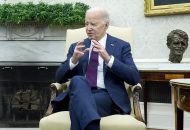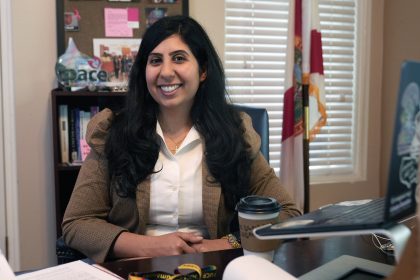Red States Push for Last-Minute Census Advantage

WASHINGTON — As the political stakes become clearer, more states are trying to motivate residents to participate in the 2020 census this spring.
Some red states had held back: Texas and Florida spent nothing on outreach, as conservatives find it distasteful to compete for population-based federal dollars when their mission is to cut back on big government. Furthermore, some conservatives in Texas and Alabama have backed the idea of counting only citizens in drawing state legislative districts, making a full count of fearful immigrants less crucial.
“Texas is making a calculation: ‘Who are these people who are likely to be undercounted and do we really want them to be counted?’ The answer is ‘no,’” said Cal Jillson, a political science professor at Southern Methodist University in Dallas.
But now even some of those states are rolling out last-minute efforts as it becomes evident that congressional seats and program dollars could be lost.
In Florida, Republican Gov. Ron DeSantis this month named a statewide committee to encourage census participation, despite showing little interest in the idea last year. Alabama, where Republicans control the legislature and the governor’s office, last month set aside $1 million for outreach.
Even Texas, which has resisted a statewide effort, hosted a roundtable discussion in December to talk about census coordination, and South Dakota Republican Gov. Kristi Noem proclaimed a Census Awareness Day in December.
Some states may be motivated in part by new projections an elections consulting firm released Dec. 30, showing that certain states stand to gain or lose a seat in Congress — for example, Florida could take one from neighboring Alabama.
Alabama needs to count only 10,000 more people to keep its seat, while Montana has a whisker-thin margin of about 2,400 residents to gain a seat, according to Kimball Brace, who based his projections for Virginia-based Election Data Services on state population trends.
“Since our study came out people are noticing it and saying ‘Hey, we’re close. If we can get it together we can do this,’” Brace told Stateline.
The analysis focuses on the states most likely to gain or lose seats. Because of the nation’s population shifts over the decade, some states will certainly lose a seat (Illinois, for example) or gain a couple of seats (Texas). But the analysis shows even more seats at play: Illinois could lose a second seat, for example, while Texas could gain a third.
Other states with one or more seats most on the bubble include New York, Montana, Florida, Alabama, Minnesota, Ohio, California and Rhode Island.
This year’s census could have the biggest political impact in those states.
The projections could change depending on how well states encourage census participation, Brace said.
States can’t count directly — that’s the task facing the U.S. Census Bureau, starting with letters to most homes in March inviting residents to call or fill out a form online. Census workers will follow up in person with those who don’t respond by May.
But states can play a big role in encouraging participation by people who may fear repercussions or just don’t see a reason for doing it. By getting a higher count, states can ensure they get their share of the $1.5 trillion in federal money distributed by population.
California is battling to keep from losing a seat for the first time in its history, spending $187 million or almost $5 for each of the state’s 40 million residents. That money goes to advertising and to grassroots organizations working with hard-to-count populations, using trusted leaders to spread the word that it’s safe to participate and helps their communities with representation and funding.
In Alabama, Republican Gov. Kay Ivey in December awarded local groups $1 million. Groups recently gathered for a statewide coordination meeting and heard state survey results on attitudes toward the census that may help concentrate last-minute efforts in five counties.
Whether new state efforts will make a difference is unclear, said Mary Jo Hoeksema, co-director of the Census Project, a private-public partnership to increase awareness of census issues.
“For some (states) their last-minute, get-out-the-count efforts may be too little, too late,” Hoeksema said. “Other states such as California and Minnesota have directed millions of dollars toward improving public awareness of participation in the 2020 census and what it means for their states.”
A member of the new Florida committee, Ginger Delegal, director of the Florida Association of Counties, said the governor had “shown his commitment” to the census effort by appointing the panel.
But Florida U.S. Rep. Donna Shalala, thinks the governor was “slow to act,” her press secretary Carlos Condarco said. Shalala is a Democrat representing the Miami-area district once held by Republican Ileana Ros-Lehtinen, who wrote about the need for an accurate count to preserve Florida’s funding and political power.
Florida needs state dollars to compete with Alabama and California’s efforts, but the governor did not provide any, said Susan Racher, a founding member of Florida Counts, a Miami-based coalition of nonprofits hoping to raise $2 million for local efforts. Floridians had low response rates in the 2010 census, raising concerns about undercounts this time around.
“It’s too late. The bull’s out of the barn,” Racher said. “Local groups have been working on fumes and they need gas money and overtime pay for somebody to man a table at a ball game, to put a census person in the carpool lane at the local Head Start. People need those trusted voices in the community but those people don’t have extra money to do this.”
Some residents in many states including Texas and Florida live in areas considered hard to count that are heavily minority and immigrant and may tend to vote Democratic. Republican lawmakers in those red states are hesitant to get involved in census outreach. And more spending for government programs may not be a priority for conservatives who see themselves as battling to shrink government.
In Texas there is “a general attitude that striving to get more federal dollars based on population isn’t something that thrills the state’s politicians,” said Chuck DeVore, a vice president at the conservative Texas Public Policy Foundation.
But some white and Republican areas also are hard to count because their suspicion of the government extends to census questions.
Alabama conducted a survey to identify five counties with concentrations of people “somewhat likely” to participate — considered an indicator that they need more information to be convinced they should do so.
Four of those counties — Chilton, Cleburne, Lauderdale and Lee — are majority-white and voted for Donald Trump in the 2016 presidential election. Also included was majority-black Wilcox County, which has voted Democratic for decades.
To have the greatest effect on participation, the state needs to concentrate its efforts in those counties, Kenneth Boswell, the chairman of the state’s Alabama Counts Initiative, said in a release this month.
“People need a greater understanding of what’s at stake for Alabama,” Boswell said. “People that were ‘somewhat likely’ (to respond) are the ones on the fence that we need to motivate to be counted. We have to share with them that it’s safe, quick, easy and matters a great deal to their community.”
Even in states like Texas that are not funding or coordinating outreach, nonprofits are trying to fill the gap. The Hogg Foundation for Mental Health gave $2 million to local Texas efforts last month, and the Community Foundations of Texas is part of a Dallas-based and statewide effort to raise money for the same purpose.
Montana, now projected by Election Data Services to gain a second congressional seat for the first time, is devoting a modest budget compared with California’s massive effort.
Montana’s legislature devoted $100,000 to census outreach last year as the chance for a second seat became clearer. That includes public service commercials set to run starting this month, and publicity campaigns encouraging people in 106 local groups to knock on doors and spread the word that the census is “easy, quick and safe,” said Emilie Ritter Saunders, a spokeswoman for the state Department of Commerce.
“Folks in Montana are good at that, keeping their neighbors informed,” Ritter Saunders said. “They rise up and meet the goal.”
———
©2020 Stateline.org
Visit Stateline.org at www.stateline.org
Distributed by Tribune Content Agency, LLC.
























